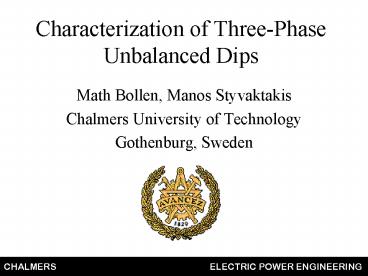Characterization of ThreePhase Unbalanced Dips PowerPoint PPT Presentation
1 / 39
Title: Characterization of ThreePhase Unbalanced Dips
1
Characterization of Three-Phase Unbalanced Dips
- Math Bollen, Manos Styvaktakis
- Chalmers University of Technology
- Gothenburg, Sweden
CHALMERS
ELECTRIC POWER ENGINEERING
2
Contents of the Presentation
- magnitude and duration - standard method
- origin of the dip
- unbalanced dips
- magnitude and duration - improved method
- examples
3
Voltage Sag Indices
?
voltage versus time
magnitude, duration, etc.
?
index
?
voltage versus time
magnitude, duration, etc.
4
Magnitude and DurationStandard method
duration
magnitude
5
Problems with the Standard Method
- three-phase unbalanced events
- three or six different voltages
- which one to choose ?
- motor starting and transformer energising
- voltage increases gradually
- separate category
- event origin
- upstream and downstream events
- who is to blame ?
6
Unbalanced Fault
7
Induction Motor Starting
8
Transformer Energizing
9
Balanced Fault
10
Causes of Voltage Dips
balanced fault
unbalanced fault
motor starting
transformer energising
11
Finding the Cause of the Dip
sharp recovery
N
Y
balanced
N
Y
Transformer - magnitude - time-constant -
unbalance
Motor - magnitude - time-constant
Fault - further classification
12
Further Classification of Fault Events
- different fault types (1ph, 2ph, 2ph-gnd, 3-ph)
- transformers between the fault and the dip
- star/delta connected measurements
13
Single-Phase Fault
star-connected load
delta-connected load
14
Phase-to-Phase Fault
star-connected load
delta-connected load
15
Classification of Unbalanced Dips
- single-phase and phase-to-phase faults
- all transformer winding connections
- type 1, no effect
- type 2, removes zero-sequence
- type 3, swaps line and phase voltages
- star- and delta-connected load
- no zero-sequence voltage at the equipment
- terminals
- only static load (constant load impedance)
16
Unbalanced dips - Type C
basic classification
symmetrical components
improved classification
17
Unbalanced dips - Type D
basic classification
symmetrical components
improved classification
18
Symmetrical Phase
Cb
Cc
Ca
Db
Da
Dc
19
Obtaining dip characteristics(2)direction of
negative sequence
V2 for dip type Cb
Dc
V1
Da
Ca
Cc
Db
20
Obtaining dip characteristics (3)
The dip type is found from the angle between
positive and negative-sequence voltage.
Characteristic voltage and PN factor are found
from the prototype event.
k0, type Ca k1, type Dc k2, type Cb k3, type
Da k4, type Cc k5, type Db
21
Characteristic Voltage, PN-factor
Type C
Type D
Fv3
F
F PN factor
22
Measurement Results - PNF
PNF
1-ph / 2-ph
The drop in PNF is due to the load
2-ph-gnd
3-ph
time
fault
post-fault
23
Alternative Method
Type C
Type D
Vv3
V
V is smallest phase-to-phase voltage magnitude
V is smallest phase-to-ground voltage magnitude
24
Alternative Method (2)
1. Calculate zero-sequence component
2. obtain rms of six voltages
25
Alternative Method (3)
3. Calculate characteristics
4. Determine dip type
- Va lowest --gt type Da
- Vb lowest --gt type Db
- Vc lowest --gt type Dc
- Vbc lowest --gt type Ca
- Vca lowest --gt type Cb
- Vab lowest --gt type Cc
26
Example 1
27
Six RMS Voltages
Vc
Vab
28
Characteristic Voltage and PNF
F
V
29
Actual Voltage
F
V/F
V
30
Duration
V
V/F
31
Phase Angles
F
V
32
Corrected Phase-Angle Jump
arg(V/F)
arg(V)
33
Overview
Dip Type Cc Magnitude 51.2 Phase-angle jump
-19.9 duration 5.3 cycles PNF
87.7 Phase-angle jump -12.4 Magnitude/PNF
56.7 Phase-angle jump -8.5 duration 4.5 cycles
phase-angle in degrees
34
Example 2
35
Fundamental Voltages
36
Characteristic Voltage and PNF
No
Tr
Da
Tr
Cc
37
Observations
- transformer saturation
- takes place at voltage recovery
- the breakers on both sides of
- the line open one cycle apart
- the breakers also close one
- cycle apart.
- The first dip is due to a two-phase-to-ground
fault - The second dip is due to a single-phase-to-ground
fault
38
Summary of the Method
input three voltage waveforms 2 or 3 complex
voltages output dip type A, C, D, M,
T magnitude and duration (phase-angle
jump) PNF phase-angle jump zero-sequence
voltage phase-angle jump PNF1 corrected
magnitude limitations the algorithms give
incorrect results for certain combinations of
V and F
39
Conclusions
- Voltage dips due to motor starting and due to
- transformer energising should be treated
separately - For three-phase unbalanced dips due to faults,
it is - possible to calculate a characteristic voltage
versus - time. Magnitude and duration of the event can be
- determined as before.
- Further algorithm development is needed to
determine - the direction of the dip.

